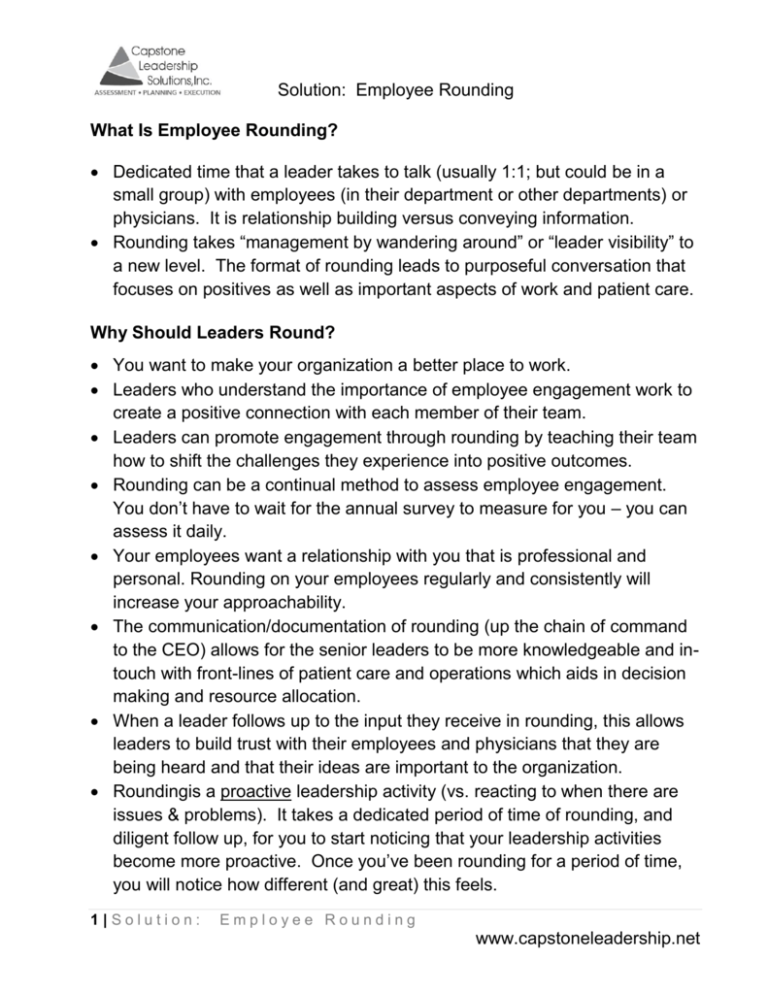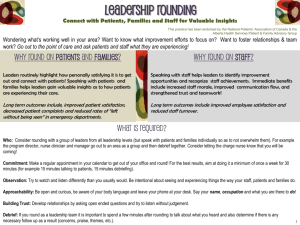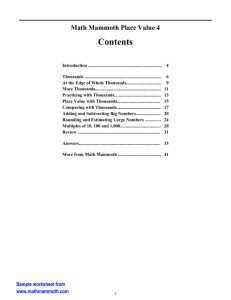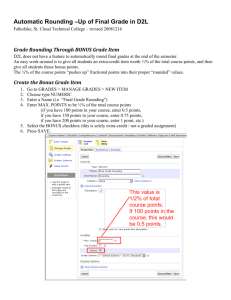What Is Employee Rounding?
advertisement

Solution: Employee Rounding What Is Employee Rounding? Dedicated time that a leader takes to talk (usually 1:1; but could be in a small group) with employees (in their department or other departments) or physicians. It is relationship building versus conveying information. Rounding takes “management by wandering around” or “leader visibility” to a new level. The format of rounding leads to purposeful conversation that focuses on positives as well as important aspects of work and patient care. Why Should Leaders Round? You want to make your organization a better place to work. Leaders who understand the importance of employee engagement work to create a positive connection with each member of their team. Leaders can promote engagement through rounding by teaching their team how to shift the challenges they experience into positive outcomes. Rounding can be a continual method to assess employee engagement. You don’t have to wait for the annual survey to measure for you – you can assess it daily. Your employees want a relationship with you that is professional and personal. Rounding on your employees regularly and consistently will increase your approachability. The communication/documentation of rounding (up the chain of command to the CEO) allows for the senior leaders to be more knowledgeable and intouch with front-lines of patient care and operations which aids in decision making and resource allocation. When a leader follows up to the input they receive in rounding, this allows leaders to build trust with their employees and physicians that they are being heard and that their ideas are important to the organization. Roundingis a proactive leadership activity (vs. reacting to when there are issues & problems). It takes a dedicated period of time of rounding, and diligent follow up, for you to start noticing that your leadership activities become more proactive. Once you’ve been rounding for a period of time, you will notice how different (and great) this feels. 1|Solution: Employee Rounding www.capstoneleadership.net Solution: Employee Rounding Why Else Should Leaders Round? Employees want efficient systems. They do not want to do re-work and face barriers every day at work. Rounding assists in finding creative solutions to breaking down barriers and roadblocks. If you don’t know about it you cannot fix it. To harvest recognition opportunities that help keep the 3:1 ratio happening. Employees need tools and equipment, training and education. Often, employees will assume you know what training and education they need. They assume you know what is broken and needs to be fixed. Asking them directly brings that information to the surface where it can easily be discussed. Rounding provides leaders with an opportunity to be a transparent and open communicator. Transparency reduces stress and negativity in your employees -- no matter what the message is. ROUNDING IS THE SINGLE MOST EFFECTIVE TOOL YOU HAVE TO MAKE EMPLOYEES FEEL APPRECIATED AND HEARD 2|Solution: Employee Rounding www.capstoneleadership.net Solution: Employee Rounding The “Why” Behind Suggested Employee Rounding Questions Relationship building question. o Relationships are key to employee engagement – rounding is all about building a relationship with your employees. Begin the conversation on a positive note. o As healthcare employees we are trained to focus to look at what’s wrong. We need to be intentional about bringing out the positives. Incorporate Leadership Safety Rounds. o Your employees are your eyes and ears. Don’t just rely on documented occurrence reports. Ask if there are any issues with tools or equipment. o Be proactive about supplies and equipment needs – not just at budget time. Ask about training and education needs. o Employees rarely offer this information to you. You must ask. Custom question(s) focused on your current improvements. o This keeps your rounding fresh for you and your employees. And, allows you to validate the progress on new initiatives. Ask about your leadership. o You may never get enough feedback from your supervisor about how you are doing as a leader. This feedback is very helpful when it comes directly from those you are leading. Do you have any “burning questions” for senior leadership? o If one employee has a question, likely others have the same question. Open ended question. o This allows the employee an opportunity to ask questions or inform you of things important to them that may not have come up in the rounding yet. Harvest opportunities for recognition. o Ends rounding on a positive note. 3|Solution: Employee Rounding www.capstoneleadership.net Solution: Employee Rounding Suggested Employee Rounding Questions How is your…..? “What is going well today?”; “What is happening that is positive today?”; “What is working well for you?” “Are you aware of anything that may pose a safety risk to our patients, employees or visitors?”; “Have you recognized or reported any good catches recently?”; “What keeps you awake at night regarding patient safety?”; “What is one way we can improve patient safety?” “Is there any equipment broken or missing?”; “What equipment or supplies would help you do a better job?”; “Do you have the tools and equipment to do your job?” “What training could we offer that would assist you in caring for your patients?”; “What educational pursuits do you have?”; “Do you have plans for BSN completion?”; “Do you have a goal for specialty certification?”, “Do you have your next job in mind?” “How are you finding the new medication reconciliation process to be working?”; “What outcomes are you seeing with the implementation of Hourly Rounding? Do you find call lights are ringing less?” “Is there anything I can be doing differently to support you?”; “What opportunities do you see for me to improve my leadership of the unit?”; “I want to always be improving my leadership. Can you tell me one thing I could do differently?” “Is there something going on in the organization that you don’t fully understand or would like to know more about?” Is there anything else I should know or any questions I can answer for you? “Who may I thank for doing a great job?”; “What employee, physician or department has gone above and beyond to serve a patient well?”; “Tell me about a co-worker or physician who has done something you would define as excellent.” 4|Solution: Employee Rounding www.capstoneleadership.net Solution: Employee Rounding Frequency of Employee Rounding Large Departments – each employee once a quarter Small Departments – each employee once a month Make it a habit – Round each day you work. When to Round Scheduled Rounding Ask employees/physicians to coordinate a date/time; get it on your calendar. Schedule employees/physicians for a specific date/time. Schedule blocks of time (preferably not in your office) and have employees sign up and/or show up during the designated time. Be flexible – it may be early mornings, evenings, other off hours. If it’s scheduled, send a copy of the rounding questions in advance so they can be more prepared with their responses. Unscheduled Rounding Ask permission – “Is this a good time?” Be cautious not to interrupt their work – you won’t have their undivided attention and they may have a bad perception regarding rounding versus the positive one you are trying to create. During down-time in the unit. Right after shift change for employees leaving their shift. Before or after a scheduled department meeting. 5|Solution: Employee Rounding www.capstoneleadership.net Solution: Employee Rounding Follow Up (and Follow Through) from Rounding Builds Trust Communicate/Document Rounding up to senior leader(s) & CEO. Make documentation simple…no more than 5 minutes to document. “Burning Questions” forwarded through rounding should be answered in an organization-wide communication (Note: We suggest that they are answered in the senior leadership team meetings and recorded in the minutes that are posted throughout the organization on the Pillar Communication Boards). Bring your rounding log (See Page 11) with you to your Monthly Accountability Meeting with your supervisor. Communicate with an employee during your next rounding (or before) with any results of your follow up actions to their rounding input. Provide recognition (e.g., Thank You Notes to Home, etc.). Acquire suggested tools and equipment. Communicate the purchase to your employees. Publicly thank the employee who gave you the suggestion. Coordinate suggested training/education. Communicate to employees that the training is in follow up to a suggestion received through rounding. Implement action steps for fixing reported system issues. Find a way to report back to your department what things are being improved based on employee input received in rounding (see Stop Light Report Example on Page 7). 6|Solution: Employee Rounding www.capstoneleadership.net Solution: Employee Rounding Department/Unit: _______________________________________________ Update Date Employee Rounding Recommendation Update Date Employee Rounding Recommendation Why is it Tabled? FUTURE IN PROCESS ACCOMPLISHED Date Employee Rounding Recommendation 7|Solution: Employee Rounding www.capstoneleadership.net Solution: Employee Rounding The Basics of Physician Rounding Physician Rounding is very similar to employee rounding. Many of the questions may be the same. Often, however, it is difficult to round with physicians without having a scheduled time. It is suggested the nursing leaders round with one physician per week if possible. This may actually require setting a meeting time with them before they start their day, during their lunch or after their office hours. If you are going to round on them without a scheduled appointment time, you would definitely want to ask if they have the time. Many administrative/senior leadership teams scheduled a group rounding (entire leadership team with an individual physician or a group of physicians). Suggested Physician Rounding Questions: Thank them for the work that they do to care for patients. What is working well? Any Safety Issues/Concerns? Do physicians feel safe knowing patients are in the care of employees when they leave at night? Two or three things can we do to improve the quality of care to your patients? Does the admission (referral, scheduling, etc.) process go well? Any Supplies, Equipment, Space and/or Training Needs? Any Burning Question(s) for Senior Leadership? Anything that leadership can do to improve communication to physicians? Responsiveness of Leaders/Supervisors? Is there an employee and/or physician you would like to recognize and why? Anything else I should know or any further questions? 8|Solution: Employee Rounding www.capstoneleadership.net Solution: Employee Rounding Senior Leader Rounding Senior Leaders round less frequently than front line leaders. A minimum of once a week is recommended. Senior leaders should be reading their leader(s) rounding notes every day. If your organization has a standard rounding time established, this is a great time for senior leaders to be in departments validating that rounding is happening. Request that your front-line leaders “invite” the CEO into a department to round on employees with a very specific agenda in mind (e.g., recognition regarding a specific goal accomplishment, to learn about an improved patient care process, etc.). Senior leaders should “harvest and deliver wins for the leader of the department”…..the senior leader should not play “the hero” at the expense of the department director. We suggest that each senior leader rounds in a different department weekly and schedules it with the leader of that department so preparation can take place (e.g., You may not want your CEO to round on an employee you have just disciplined without the CEO knowing about it). A brief standardized report format may help prepare the senior leader for rounding in your department. This brief report could include: Recent accomplishments New Equipment Employees to Recognize Employees to Coach/Mentor Tough Questions/Issues Physician Activities/Issues Current Patient Satisfaction Results Other goal results (employee sat, quality, etc.) Other “heads up” issues 9|Solution: Employee Rounding www.capstoneleadership.net Solution: Employee Rounding Support Department Leader Rounding Support Department Leaders have a unique ability to break down silos in an organization by rounding with the front line employees providing patient care. It is great to ask: “how can our department help you to serve our patients better?” Support Department Leaders should round daily with their own employees or employees in departments that are served by their department. Support Department Leaders who round daily and harvest wins can create a bond between employees in other departments. For example if an RN tells you to thank one of your support department employees for a job well done, you now have an opportunity through recognition to create positive feelings between your employee and the RN. Training Leaders and Holding them Accountable for Rounding Rounding (with purpose) is a new leadership skill for most leaders. The “whys and how” should be taught and practiced. Many organizations develop a “competency assessment” in which leaders are observed and their skills validated. Having leaders post a “stop light” report is a visible sign that rounding is happening and is gaining results. Having leaders document and “communicate up” their rounding reports is also validation that rounding is being done. Some organizations track documented roundings and report them, by leader, monthly at a leadership meeting. For organizations that adopt Monthly Accountability Meetings, rounding logs and documentation are a key standing agenda topic. This is also a time in which senior leaders can assist leaders with any barriers to consistent rounding and/or improving rounding techniques. Be the change you want to see in others – ROUND, even if no one else is. You can make a difference. 10 | S o l u t i o n : Employee Rounding www.capstoneleadership.net Solution: Employee Rounding Sample Rounding Tracking Form Week M T W R F Use Codes or Name or Other Identifiers in Spaces Above Codes: P = Patient D = Doctor E = Employee P = Patient 11 | S o l u t i o n : Employee Rounding V = Visitor S = Support Department www.capstoneleadership.net






